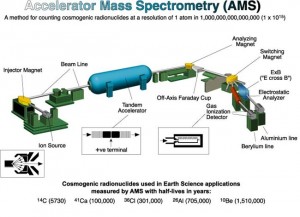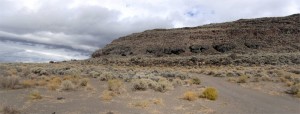Coprolites are fossilized feces that can be analytically examined to understand archaeological events. Fourteen coprolites were found by archaeologists at the lowest levels of the Paisley 5-mile point caves in south-central Oregon. The coprolites found it this site were morphologically human based on the size, shape, consistency, and color. Upon further analysis using multiplex polymerase chain reaction (PCR), all fourteen coprolites tested positive for human mitochondrial DNA (mtDNA). The next step for the archaeologists was to date the age of these coprolites.
The coprolites were dated using an accelerator mass spectrometry (AMS) system. This radiocarbon dating system found that the three oldest produced an age of 12,300 14C years B.P. To ensure the validity of these coprolites dates, the archaeologists sent the five coprolites from the deepest layers to be direct dated by AMS at two independent laboratories; Beta Analytic in Florida, USA and Oxford Radiocarbon Accelerator Unit at the University of Oxford, UK. These two labs used two different methodologies for analyzing the coprolites and could be cross examined for accuracy. From the five coprolites sent to both labs, four produced consistent dates ranging approximately 1300 to 12,300 14C years B.P. and three pre-dated 11,000 14C years B.P. This data confirms that humans were present in North America before the Clovis people.

A breakdown of the Accelerator Mass Spectrometry system that was used to detect and analyze the long-lived radionuclides in the coprolites.
The Clovis people are a group of prehistoric Native Americans commonly thought to be the first human inhabitants of North America. They are named after the town where their artifacts were found in Clovis, New Mexico and they inhabited the area around 11,000 14C years B.P. The latest coprolite studies from Oregon question the age of North American inhabitants. Many other pre-Clovis occupation sites have been recorded around North America but they remain controversial because of the lack of human artifacts to accurately date the sites. The coprolites found at the Paisley 5 mile point caves are so crucial because they undisputedly confirm pre-Clovis humans. The DNA in the coprolites not only dated the age of the humans who produced them, but they also gave us an insight to their diet.
Many of the coprolites contained canid 16S mitochondrial DNA that is similar to the red fox, coyote, domestic dog, or wolf. Among the coprolites the archaeologists also found a diverse amount of canid bones. The two most likely explanations for these findings are that the earliest humans in North America included canids in their diet or that canids inhabited the caves during nonhuman occupation and directly urinated on the human feces. Both theories give us insight to the past and the importance of coprolite analysis in resolving the historical record.
Additional Links
What AMS is and how it is works:
https://www.physics.purdue.edu/ams/introduction/ams.html
Analysis of Coprolites found in the Hidden Caves of western Nevada:
Sources
http://www.sciencemag.org/content/320/5877/786.abstract?sid=a3a9f1cd-0fc8-41b9-a01a-adc8d4c26fe7
http://www.nytimes.com/2008/04/04/science/04fossil.html?_r=0
http://www.crystalinks.com/clovis.html
Picture links


Although many associate archaeology purely with the study of human societies, it can in fact reveal a great deal about animals and the environment at large. I am struck by the fact that “many of the coprolites contained canid 16S mitochondrial DNA that is similar to the red fox, coyote, domestic dog, or wolf,” which you note possibly indicates either the dietary preferences of the Clovis people or that these animals occupied their caves later on. Archaeology can therefore be a key means of learning about animal-human relationships over time. It can also reveal a great deal about how animals and humans differently function within or occupy the same spaces. What is the significance of learning about humans and other animals? What are the implications of this knowledge for our society today? How else can we learn more about this relationship archaeologically?
There is a huge significance of learning about humans and other animals because the present is the way it is only because of what happened in the past. By looking into the past and studying the development of human-animal relationships we can gain a better understanding about how we all currently coexist and if it has always been that way or it has changed over time. The implications of this is to gain a better understanding of how the relationships have evolved so that we can continue to maintain them if they are positive relationships, or look for a way to change them if it is a negative relationship. We can learn more about this relationship archaeologically by looking for animal DNA in the surrounding environment, not just the close immediate environment, when human remains are found. Finding this connection between commonly shared environments, we can further understand how we coexist with them and how the relationship has changed over time with the limited amount of land, resources, and how each adapt to the inevitable deterioration/depletion of the environment.
Human consumption of dogs is a touchy subject because so many people think of dogs as furry non-verbal humans. But dog domestication may not have been much different than sheep or cow domestication. If not a regular part of the human diet, dogs certainly provided a meal option when other sources of protein were scarce.